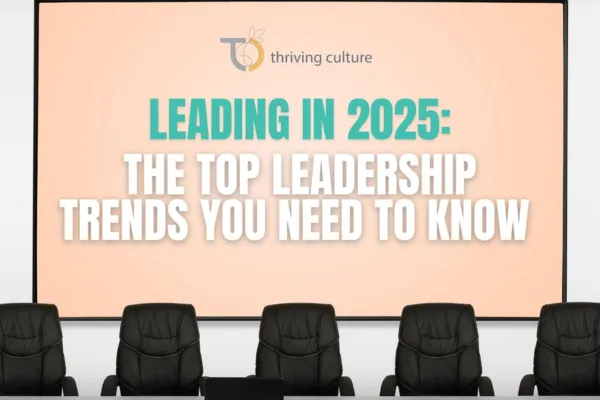
Leading in 2025: The Top Leadership Trends You Need to Know
Leading in 2025: The Top Leadership Trends You Need to Know

Leadership is evolving at a rapid pace. Whether you're leading a team, an organisation, or guiding culture and strategy in a People & Culture role, the expectations have never been higher. Between economic shifts, new legislation, and the rapid rise of AI, leaders must be more adaptable, people-focused, and future-ready than ever before.
Here are the top 6 leadership trends shaping workplaces in 2025—and what you can do to stay ahead.
1. The AI Revolution – Requires Human Connection
AI is no longer a futuristic concept—it’s here, and it’s transforming how businesses operate. From automation in HR to AI-driven decision-making, leaders must strike a balance between technology and human connection. The true value of AI lies in its integration with human insight. While AI can enhance efficiency, it’s up to leaders to ensure that the human aspects of leadership—creativity, emotional intelligence, and ethical decision-making—remain front and centre.
What this means for you:
Upskill yourself and your team—Understand where AI can support decision-making but ensure people remain at the heart of business operations.
Create a learning culture—AI is evolving fast, and so should your team’s capabilities. A team that adopts a growth mindset will continue to learn and grow.
2. Comfort in the Discomfort of Change and Ambiguity
If the last few years have taught us anything, it’s that uncertainty is the new normal. Economic pressures, shifting workforce expectations, and new legislative changes like Australia’s Right to Disconnect law mean leaders must be clear, adaptable, and thoughtful in how they manage change.
How to lead change effectively:
Be clear about what’s in your control—Your team will look to you for stability, even in uncertain times.
Share when you don’t have the answer—When leading people through change understand the social threats that they may be experiencing. Role model vulnerability and share when you don’t have the answers.
3. Accountability, Not Burnout
Work-life balance is a business issue. Australia’s new Right to Disconnect law means employees can decline work-related calls or emails outside of their standard hours unless it’s reasonable. This challenges the ‘always-on’ work culture and pushes leaders to focus on outcomes over hours.
How to embed accountability while respecting boundaries:
Clarify priorities and expectations—Accountability doesn’t mean overworking people. It’s about setting clear goals and ensuring work gets done during working hours.
Lead by example—If you email your team at 10 pm, they may assume they need to be online. Instead, role-model healthy boundaries to build a high-performing, sustainable work culture. Use the send later function so the email arrives the following morning.
4. Coaching Over Commanding
Leaders who coach rather than simply direct build stronger, more engaged teams. Coaching isn’t about having all the answers—it’s about asking the right questions, empowering team members to think critically, and developing their capabilities.
Why coaching should be your go-to leadership style:
Better problem-solving & engagement—Teams that feel supported take ownership of their work.
Stronger talent development—Coaching leaders build future leaders, rather than just managing tasks.
5. Building Feedback-Rich Cultures
Feedback isn’t an event—it’s a culture. Many leaders avoid giving feedback because they worry about difficult conversations, but when done well, feedback drives performance and growth. The key is to create an environment where feedback flows in all directions—up, down, and sideways.
How to create a feedback culture:
Give feedback early and often—Don’t wait for performance reviews to have real conversations.
Teach your team to receive feedback well—We teach teams not just how to give feedback, but how to receive it with curiosity and action.
6. The Rise of Human-Centred Leadership
In an era of AI, automation, and change fatigue, one thing remains constant: people want to work for leaders who genuinely care. Leadership today requires emotional intelligence, transparency, and the ability to build meaningful connections.
How to be a human-centred leader:
Be real with your team—Authentic leadership builds trust. Flex between assertive, empathetic, and adaptive leadership to respond effectively to changing situations.
Understand your people beyond their job titles—Get to know what motivates them, what challenges them, and how you can support their growth.
The world is changing, leaders need to be more adaptable, human, and accountable than ever before.
Leadership is a skill, not just a title. The good news is this skill can be developed.
We believe that the best leaders create environments where people thrive. Whether it’s through our leadership programs, Thriving Leaders Program, coaching, or our Thriving Academy, we help leaders develop the skills to lead confidently and authentically. We’re passionate about equipping leaders with practical, real-world tools to build high-performing teams, lead through change, create a culture of accountability, feedback and coaching so that you lead with confidence.
Do you feel equipped in 2025 to lead confidently?
P.S. Facing challenges with team alignment, culture, or retention? Here are some ways we can work together:
Leadership development programs that empower your leaders to lead with confidence and navigate change.
Bespoke workshops addressing your specific team and leadership needs.
Read Thriving Leaders: Learn the Skills to Lead Confidently, you can purchase it here.
If you’d like to chat, please book some time in my calendar.
